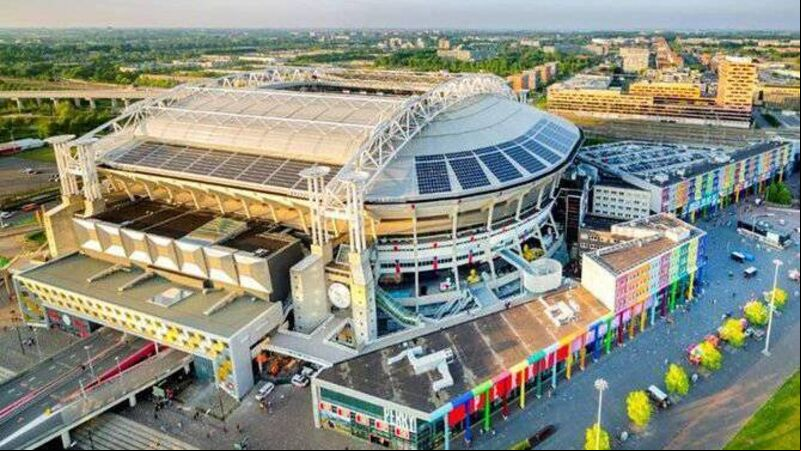We all need to Cop26 on to climate crisis, including sport

The Johan Cruyff Arena in Amsterdam, home to Ajax and a world leader in energy sustainability.
THE Conference of Parties on climate change, better known as 'Cop26', starts this weekend in Glasgow. It's a gathering of the nations of the world to negotiate a planet-wide strategy to tackle the climate crisis.
As a universal crisis facing all of humanity, it's important for sporting bodies and people involved in sport, to face up to their responsibilities regarding their impact on the environment.
It's estimated that professional sports for 1% of global greenhouse emissions. This does not include the far larger amateur or recreational sporting sectors.
Addressing the crisis as an industry sector is not only the responsible thing to do but also the smart thing to do, as global warming is already making playing outdoor sports impossible in many parts of the world.
The impact made by big sports clubs and leagues is more obvious. The construction of large stadiums and the concrete plaza all have carbon production side-effects. Energy consumption from internal heating to huge floodlighting is significant. Water use for grass upkeep and stadium use can be huge and requires energy-intense processing for safe use by local authorities.
The production, processing, and delivery of food and drink from around the world for players, staff, and fans is a huge drain on transport. And then there's the carbon footprint from incessant new kit production, as well as the transport of teams, staff, and equipment by airlines, often to the other side of the world.
It doesn't have to be like this, there are some notable examples made by big clubs and businesses that are far ahead of many of their peers.
One such 'brand leader' in the respect of their environmental achievements is the Johan Cruyff Arena, home to AFC Ajax in Amsterdam. The stadium's retractable roof is covered in tech that includes 4,200 solar s, wind turbines at its elevated levels and water gathering infrastructure that collects rainwater for use in cooling changing rooms and irrigating the pitch. That pitch is kept frost-free with a sustainable air pump heating system. And when the grass gets too long, it’s trimmed only with electric mowers.
80% of the lighting in the stadiums uses low-energy LED bulbs while the club uses recycled batteries from electric cars to store the energy from the renewable sources on the roof, removing the need for costly and dirty diesel generators.
Fans and players alike are fed from menus that source ingredients locally from sustainable farms.

Formula 1 is one sport many would imagine is a poster child for the use of unsustainable resources. And in the past, this would be true. But the sport seems to be making a genuine effort to address its obvious carbon footprint. F1 say their sport will be carbon neutral by 2030 which includes advances in design and the development of sustainable biofuel for their F1 engines. The sport has pledged to move towards “ultra-efficient” travel and logistics and 100% renewably powered offices, facilities and factories by 2025, with all waste being recycled, reused or composted.
All good 'promises' a cynical mind might say, but F1 has already established a centralised media hub, based in London, removing the need for multiple media organisations to travel en masse from Grand Prix to Grand Prix shipping tonnes of equipment each week and it is that idea of the distribution of resources rather than carrying them everywhere they go that offers the sport its best hopes of going green.
While Croke Park is notable for their energy efficiencies and water storage programmes, as well as sustainable waste programmes and biodiversity projects within the grounds of the famous stadium, they are the exception when it comes to GAA and the broader Irish sporting green credentials.

There should be no excuse for professional sports organisations not striving to have renewable sources of energy working on their behalf on the roofs of the many, many stadiums we have across the country.
But this is true for small clubs too, the outlay for solar and/or wind infrastructure would pay for itself in no time and provide clean, almost free energy that can be used by the club or sold to the grid as an additional stream of revenue. They could also store energy in battery banks that could be used to charge the electric vehicles of club which would also encourage EV adoption.
Local clubs could do a lot more regarding waste and rainwater management. The design of clubhouses should strive to use natural light as much as possible, while LED lighting is necessary in all other situations.
Training and matches should see the end of single-use plastic drink bottles used by players, while removing them from the clubhouse bar is not a bad idea either, along with broader recycling projects for old kits and equipment.
While the Cop26 elites discuss the serious climate issues threatening our future, it offers all of us involved in sport a chance to reconsider our own choices and impacts on our environment.










 App?
App?







